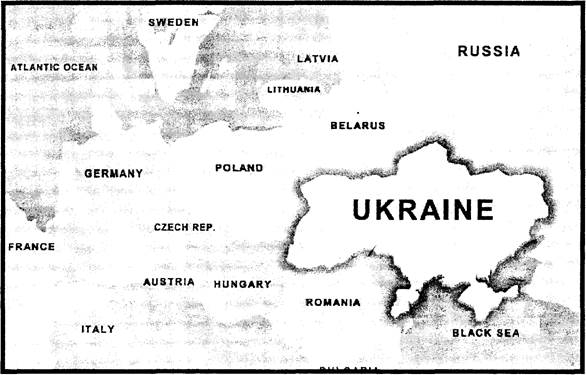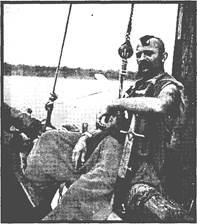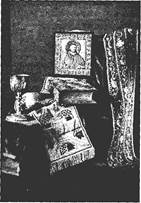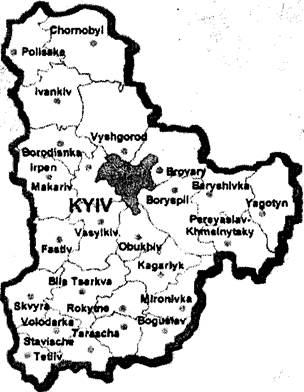The national emblems include the coat of arms, the flag, and the seal.
ПЕРЕДМОВА
Даний посібник “UKRAINE, GREAT BRITAIN, THE USA” з країнознавства призначений для позааудиторного читання для студентів I-II курсів аграрних спеціальностей.
Посібник націлений на забезпечення розвитку навичок самостійного читання та перекладу іншомовного матеріалу.
Посібник складається з 6 розділів, кожен з яких має тексти для читання, практичні завдання до них з метою контролю розуміння змісту текстів та контрольні запитання до кожного розділу. Тексти містять інформацію, спрямовану на розширення світогляду студентів стосовно географічного положення, освіти та соціально-культурного розвитку України, Великобританії та США.
Тексти в адаптованому вигляді взято із зарубіжних та вітчизняних видань, що сприяє поповненню та вдосконаленню лексико-граматичних навичок студентів.
UNIT I
UKRAINE, OUR HOME
There is no place like home.
Ukrainian proverb
How much do you know?
Ø When was the term Ukraina first mentioned?
Ø What do you know about founding of Kyiv?
Ø Who said: “Let Kyiv be Mother of Rus Cities”?
Ø How have scholars divided Ukrainian dialects?
Ø What do you know about the schooling system of our country?
UKRAINE

Pages of History
 Today, Ukraine is included in all the world atlases. But there did exist maps on which Ukraine was not designated. In the past foreign invaders tried more than once to destroy her and repeatedly tried to enslave the country.
Today, Ukraine is included in all the world atlases. But there did exist maps on which Ukraine was not designated. In the past foreign invaders tried more than once to destroy her and repeatedly tried to enslave the country.
For many decades fierce battles thundered over Ukraine, antifeudal and peasant-cossack uprisings engulfed her.
Today Ukraine occupies a leading place in world science and technology. The scientists of Ukraine are engaged in researches in the most important trends of scientific-technical progress.
The term Ukraina was first mentioned in the chronicles in the 12th century as a geographical name for the southern lands of the ancient Rus State. In the process of the creation of a Ukrainian nationality the name Ukraine began to be associated with southwestern Rus territories of Kyiv, Chernigiv, Volyn, Podillya, Eastern Galicia, Transcarpathia, Northern Bukovyna and Zaporizhya regions.
With time the people who lived on those lands became to be known as Ukrainians. Ukrainians speak the Ukrainian language. According to UNESCO Ukrainian occupies 22nd place among the world languages and second place among the Slav languages after Russian.
The national emblems of Ukraine
The national emblems include the coat of arms, the flag, and the seal.
The contemporary national coat of arms of Ukraine is Azure, a trident or. It is the most ancient and dignified of all the Ukrainian insignia.
The horizontally stripped flag, blue over yellow, became the national flag all over Ukraine.
The Ukrainian Anthem, Ukraine Has Not Yet Perished, is of quite recent origin.
What is Ukraine's territory?
The territory of Ukraine is 603,7 thousand square kilometers. Two such countries as Italy can be placed on this territory. Ukraine occupies 42nd place in the world as to its territory being larger than any country in Western Europe. Ukraine stretches for 1300 km from east to west and 900 km from north to south.
Ukraine borders on Russia, Moldova, Rumania, Hungary, Slovakia, Poland and Belarus. The geographical position of Ukraine is ideal for the development of its resources.
Theclimate of Ukraine is mild and warm, with a long summer and a short winter. Together with its fertile black soil it is ideal for the development of intensive agriculture. Eastern Ukraine is slightly colder in winter and warmer in summer than Western Ukraine. Temperatures in Kharkiv average -7°C in January and +20°C in July, in Lviv -4°C and +18°C.
Ukraine is the country of manyrivers. The Dnieper (Dnipro) River divides Ukraine into two parts: Right Bank and Left-Bank Ukraine. The Danube gives Ukraine access to European countries and the Siversky Donets - to the Don.
In the south Ukraine is bounded by theBlack Sea and theSea of Azov. The Black Sea and navigable rivers have promoted the development of trade and culture.
Ukraine consists of a flat, fertile plain occupied by steppes and forest-steppe regions.Lowlandsoccupy a considerable part of the country. The Polissia Lowland lies in the north. The Dnieper Lowland runs along the left bank of the Dnieper River. The Black Sea Lowland skirts the Black Sea and the Sea of Azov.
Within the borders of Ukraine there are the CarpathianMountains with the highest peak Hoverla 2061 m high. The Carpathians have flat summits and gentle slopes. There are many treeless summits, which are called polonynas.
The Crimean Mountains with their southern steep slopes stretch in three parallel ranges. The highest peak of the Main Range Roman Kosh is 1545 m high.
The economic potential of Ukraine is great. Ukraine is criss-crossed by railroads and highways oil and gas pipelines. It has close economic ties with Eastern and Western Europe.
Religion.
 Ukrainians have remained a strongly religious people in spite of decades of religious restriction. About 80 of Ukrainians are Orthodox Christians. Other groups include Ukrainian Catholics, Protestants, and Jews.
Ukrainians have remained a strongly religious people in spite of decades of religious restriction. About 80 of Ukrainians are Orthodox Christians. Other groups include Ukrainian Catholics, Protestants, and Jews.
Most Orthodox Christians live in Eastern and central Ukraine and belong to the Ukrainian Autocephalous /Independent/ Orthodox Church.
About 10 percent of Ukraine's people are Ukrainian Catholics, also known as Uniates or Greek Catholics. The Ukrainian Catholics practice Eastern Orthodox forms of warship, but they recognize the authority of the Roman Catholic pope. The Church is strongest in the Western Ukraine. The Moslems of Ukraine practice Islamic forms of warship mostly in Crimea and Eastern Ukraine.
National government.
Ukraine is an independent state since adoption of the Declaration on State Sovereignty of Ukraine on July 16,1990.
In accordance with the Constitution of Ukraine adopted on June 28,1996 Ukraine has a democratic political system. The country's government features an executive branch headed by the President with strong powers, a legislative branch consisting of a national parliament and the judicial, which headed by the Supreme Court.
The President is commander in chief of the military and can issue orders called edicts without the approval of parliament in some matters. The people of Ukraine elect the President to a five-year term. Ukrainians 18 years old or elder may vote.
The President is assisted by aCabinet, which the president appoints. A Prime Minister heads the Cabinet.
Ukraine's parliament, called theSupreme Council, is the nation's lawmaking body. It has 450 members, who are elected by the voters. Supreme Council members serve five-year terms. The Supreme Council discusses and adopts the State Budget for the coming year.
TheSupreme Court and theConstitutional Court represent the judicial power. They watch over the executive and legislative powers.
Local government.
Ukraine, excluding Crimea, is divided into 24 regions called oblasts. Crimea has special status as an autonomous /self-governing/ republic. Crimea has greater control over the internal affairs than do the oblasts. The Crimean Autonomous republic has its own constitution.
Armed forces.
Ukraine has an army, air force, and a small navy. December 6 is the Day of the Armed Forces of Ukraine.
KYIV
Kyiv (population 2616000) is the capital and largest city of Ukraine. The city is also the political, economic, and cultural center of Ukraine. It lies in north-central Ukraine on the Dnieper (Dnipro) River, in a rich agricultural and industrial region.
 The central area of Kyiv lies on the hilly western bank of the Dnieper. There buildings dating from the Middle Ages to the present stand near each other.
The central area of Kyiv lies on the hilly western bank of the Dnieper. There buildings dating from the Middle Ages to the present stand near each other.
Landmarks of Kyiv includeSt. Sophia's Cathedral and theGolden Gate of Yaroslav the Wise, both completed in 1037. TheMonastery of the Caves, which has a network of catacombs, also dates from the Middle Ages.
TheMarinsky Palace and theChurch of St. Andrew, both built during the mid - 1700's, are important examples of the architecture of that period.
Kyiv is known for its attractive parks and famous Main Boulevard,Khreshchatyk Street. The city has a number of colleges, universities, and research institutes. Kyiv also has many museums and theatres.
Kyiv is a major manufacturing and transportation center. Its chief products include chemicals, clothing, footwear, instruments and machinery.
The city is an important highway and railroad junction, an air transportation hub and a busy river port.
Kyiv's beginnings go back to the Stone Age. There isa legend about founding of Kyiv. Once there were three brothersKyi, Shchek and Khoriv, and they had a young sister Lybed. They founded a city on the hills and called it Kyiv after the eldest brother. It is believed that Kyi did exist - that he was a Prince of the Poliane tribe and lived in the 7th century.
The city was founded by Slavic people, possibly as early as the A.D. 400's. In 882 PrinceOlegof Novgorod, having seized Kyiv, was known to have said: "This will be the mother of all Russian towns!" The Novgorod principality united with that of Kyiv, and the town was made the capital of a unified Russian state. Kyiv prospered as a trading center and, during the late 800's became famous as the capital of the first East Slavic State, called Kyivan Rus. By the 1000's, Kyiv was one of Europe's greatest centers of commerce and culture and known as the rival of Constantinople.
Kyiv remained the capital for nearly three centuries. Gradually other feudal centers came into being. The independent princes undermined the authority of the Grand Duke of Kyiv and led to disintegration.
In December 1240 the Mongol-Tatar forces led by Khan Batu besieged Kyiv. Mongol invaders destroyed much of the city in 1240. It was only by a miracle that the Cathedral of St. Sophia, St. Michael's Monastery and the Golden Gate survived the invasion half-ruined. The Mongol-Tatars ruled Kyiv more than a century.
Kyiv was rebuilt in the 1300's. It came under Lithuanian rule in 1362 and under Polish rule in 1569. Russia regained control of Kyiv in 1654 after thePereyaslav Rada /Council/ adopted a decision on the reunification of Ukraine and Russia.
In 1793 the two parts of Ukraine united within the Russian State and in 1797 Kyiv became the capital of the Kyiv, Volhynia and Podillia Provinces. In 1632 the Kyiv MohylaAcademy was founded. The great Russian scientist Mykhallo Lomonosov, the outstanding Ukrainian philosopher Grygory Skovoroda, and the historian Dmytro Bantysh-Kamensky were all students of the Kyiv Academy.
In 19th century Kyiv became the chief center of the economic, political and cultural life of Ukraine. In 1805 the first theatre was opened. The great Russian poet Alexander Pushkin lived in Kyiv for a while during 1821. Kyiv University was inaugurated in 1834.
In January 1846 the"Cyril and Methodius" Society was founded in Kyiv. Taras Shevchenko, the outstanding Ukrainian poet, was the leader of its wing.
After the fall of tsarism in 1917-1918 the Provisional Government and the Central Rada under M.S.Grushevsky /i866-1934/ established in Kyiv. In 1918-20 Kyiv became the scene of the fierce battles of the civil war.
In 1934 Kyiv became the capital of the Ukrainian Republic and the Government was transferred from Kharkiv. From 1941 to 1943, duringWorld War II, the city was occupied by the German army and was badly damaged. It was rebuilt after the war and has grown rapidly.
In 1986, an explosion and fire occurred in a nuclear reactor at Chernobyl, near Kyiv. In 1991 the Ukrainian republic declared itself an independent nation and Kyiv becamethe capital of independent and sovereign Ukraine.
THE UKRAINIAN LANGUAGE
The Ukrainian Language is the second most widely spoken language of 12 surviving members of the Slavic group of the large Indo-European language family. Geographically, it is classified with Russian and Belarussion as an East Slavic language.
Ukrainian is represented basically by a set of dialects, some of which differ significantly from the others. Generally, however, dialectical divisions in Ukrainian are not so strong as they are, for example, in British English or German. Traditionally, scholars have divided Ukrainian dialects into three main groups, northern, southwestern, and southeastern. Standard Ukrainian is a superstructure built on this dialectal foundation. It is the only form of Ukrainian taught in school and used in literature. The standard language is based mainly on the Poltava-Kyiv dialects of the southeastern group.
On 28 October 1989 the Supreme Soviet of the UkSSR passed the law "On languages in the Ukrainian SSR", which gives official status to Ukrainian and provides its introduction in the legislation, ministry, civil organizations and enterprises, the court system, international treaties and agreements, the school system from kindergarten to higher educational institutions, scientific publications and the mass media.
THE SYSTEM OF SCHOOLING
